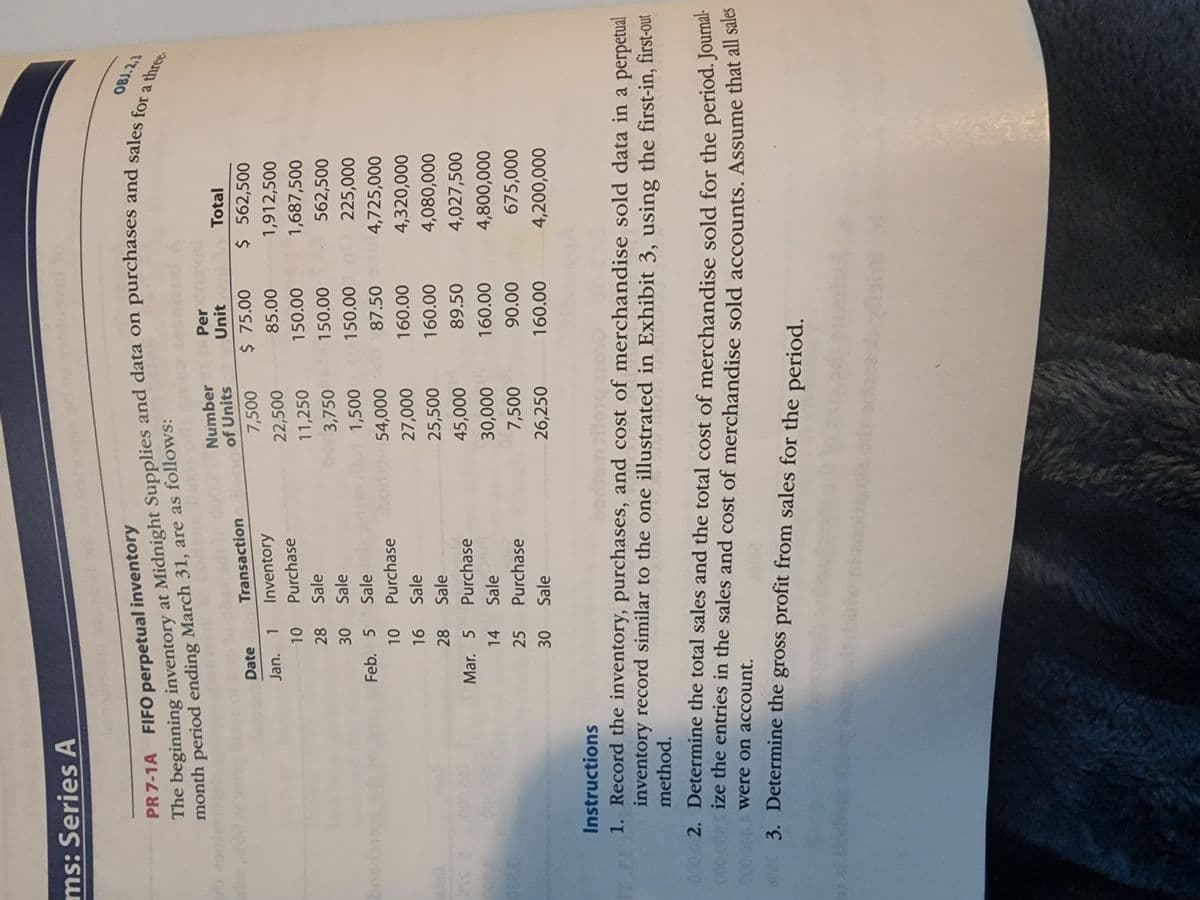s: Series A OBJ. 2,1 PR 7-1A FIFO perpetual inventory The beginning inventory at Midnight Supplies and data on purchases and sales for a three- month period ending March 31, are as follows: Date Jan. 1 10 28 30 Feb. 5 10 Transaction Inventory Purchase Sale Sale Sale Purchase 16 Sale 28 Sale Mar. 5 Purchase 14 Sale 25 Purchase 30 Sale Number of Units Per nav Unit 7,500 $ 75.00 85.00 150.00 bo 3,750 150.00 22,500 11,250 M 27,000 25,500 45,000 30,000 7,500 26,250 1,500 150.00 54,000 87.500 160.00 160.00 89.50 160.00 90.00 160.00 Total $ 562,500 1,912,500 1,687,500 562,500 225,000 4,725,000 4,320,000 4,080,000 4,027,500 4,800,000 675,000 4,200,000 Instructions 1. Record the inventory, purchases, and cost of merchandise sold data in a perpetual inventory record similar to the one illustrated in Exhibit 3, using the first-in, first-out method. 000 were on account. 23. Determine the gross profit from sales for the period. 0.02. Determine the total sales and the total cost of merchandise sold for the period. Journal odeesize the entries in the sales and cost of merchandise sold accounts. Assume that all sales
s: Series A OBJ. 2,1 PR 7-1A FIFO perpetual inventory The beginning inventory at Midnight Supplies and data on purchases and sales for a three- month period ending March 31, are as follows: Date Jan. 1 10 28 30 Feb. 5 10 Transaction Inventory Purchase Sale Sale Sale Purchase 16 Sale 28 Sale Mar. 5 Purchase 14 Sale 25 Purchase 30 Sale Number of Units Per nav Unit 7,500 $ 75.00 85.00 150.00 bo 3,750 150.00 22,500 11,250 M 27,000 25,500 45,000 30,000 7,500 26,250 1,500 150.00 54,000 87.500 160.00 160.00 89.50 160.00 90.00 160.00 Total $ 562,500 1,912,500 1,687,500 562,500 225,000 4,725,000 4,320,000 4,080,000 4,027,500 4,800,000 675,000 4,200,000 Instructions 1. Record the inventory, purchases, and cost of merchandise sold data in a perpetual inventory record similar to the one illustrated in Exhibit 3, using the first-in, first-out method. 000 were on account. 23. Determine the gross profit from sales for the period. 0.02. Determine the total sales and the total cost of merchandise sold for the period. Journal odeesize the entries in the sales and cost of merchandise sold accounts. Assume that all sales
Financial And Managerial Accounting
15th Edition
ISBN:9781337902663
Author:WARREN, Carl S.
Publisher:WARREN, Carl S.
Chapter6: Inventories
Section: Chapter Questions
Problem 2PB: LIFO perpetual inventory The beginning inventory for Dunne Co. and data on purchases and sales for a...
Related questions
Question
Only. #4 and #5.

Transcribed Image Text:Chapter 7 Inventories
387
4. Determine the ending inventory cost as of March 31.
5. Based upon the preceding data, would you expect the inventory using the last-in, first-
out method to be higher or lower?

Transcribed Image Text:ms: Series A
brsrions
ers
OBJ. 2,3
PR 7-1A FIFO perpetual inventory
The beginning inventory at Midnight Supplies and data on purchases and sales for a three-
month period ending March 31, are as follows:
Date
Jan. 1
10
28
30
Feb. 5
10
16
28
Mar. 5
14
25
30
Transaction
Inventory
Purchase
2013
Sale
Sale
Salech
Purchase
Sale
Sale
Purchase
Sale
Purchase
Sale
Number
of Units
7,500
22,500
11,250
3,750
1,500
54,000 9
27,000
25,500
45,000
30,000
7,500
26,250
Per
Unit
$ 75.00
85.00
150.00
150.00
150.00
87.50
160.00
160.00
89.50
160.00
90.00
160.00
Instructions
1. Record the inventory, purchases, and cost of merchandise sold data in a perpetual
inventory record similar to the one illustrated in Exhibit 3, using the first-in, first-out
method.
Total
$ 562,500
1,912,500
1,687,500
562,500
225,000
4,725,000
4,320,000
4,080,000
4,027,500
4,800,000
675,000
4,200,000
000,0 2. Determine the total sales and the total cost of merchandise sold for the period. Journal-
ize the entries in the sales and cost of merchandise sold accounts. Assume that all sales
were on account.
23. Determine the gross profit from sales for the period.
ht
Expert Solution
This question has been solved!
Explore an expertly crafted, step-by-step solution for a thorough understanding of key concepts.
This is a popular solution!
Trending now
This is a popular solution!
Step by step
Solved in 2 steps with 3 images

Follow-up Questions
Read through expert solutions to related follow-up questions below.
Follow-up Question

Transcribed Image Text:Chapter 7 Inventories
387
4. Determine the ending inventory cost as of March 31.
5. Based upon the preceding data, would you expect the inventory using the last-in, first-
out method to be higher or lower?
Solution
Knowledge Booster
Learn more about
Need a deep-dive on the concept behind this application? Look no further. Learn more about this topic, accounting and related others by exploring similar questions and additional content below.Recommended textbooks for you

Financial And Managerial Accounting
Accounting
ISBN:
9781337902663
Author:
WARREN, Carl S.
Publisher:
Cengage Learning,

Corporate Financial Accounting
Accounting
ISBN:
9781305653535
Author:
Carl Warren, James M. Reeve, Jonathan Duchac
Publisher:
Cengage Learning

Financial Accounting
Accounting
ISBN:
9781305088436
Author:
Carl Warren, Jim Reeve, Jonathan Duchac
Publisher:
Cengage Learning

Financial And Managerial Accounting
Accounting
ISBN:
9781337902663
Author:
WARREN, Carl S.
Publisher:
Cengage Learning,

Corporate Financial Accounting
Accounting
ISBN:
9781305653535
Author:
Carl Warren, James M. Reeve, Jonathan Duchac
Publisher:
Cengage Learning

Financial Accounting
Accounting
ISBN:
9781305088436
Author:
Carl Warren, Jim Reeve, Jonathan Duchac
Publisher:
Cengage Learning

Intermediate Accounting: Reporting And Analysis
Accounting
ISBN:
9781337788281
Author:
James M. Wahlen, Jefferson P. Jones, Donald Pagach
Publisher:
Cengage Learning

Cornerstones of Financial Accounting
Accounting
ISBN:
9781337690881
Author:
Jay Rich, Jeff Jones
Publisher:
Cengage Learning